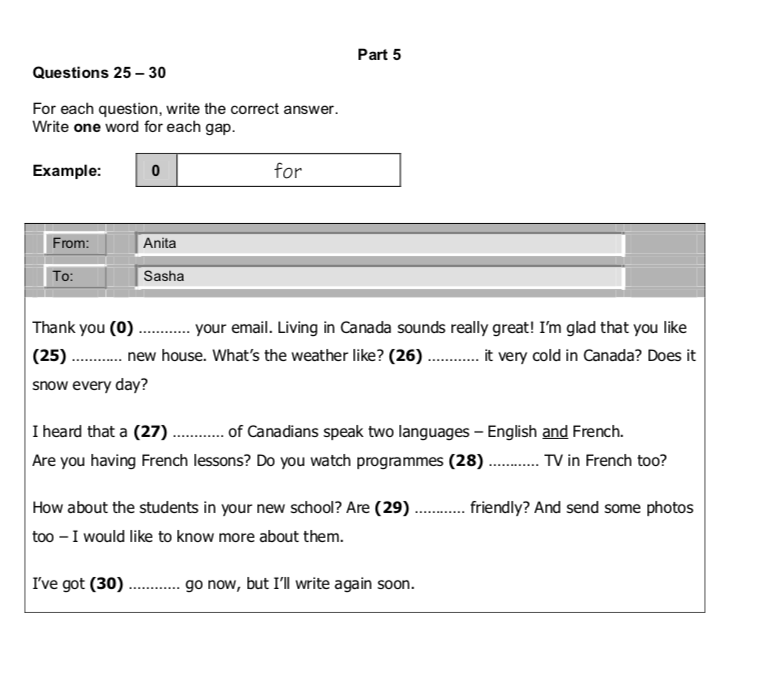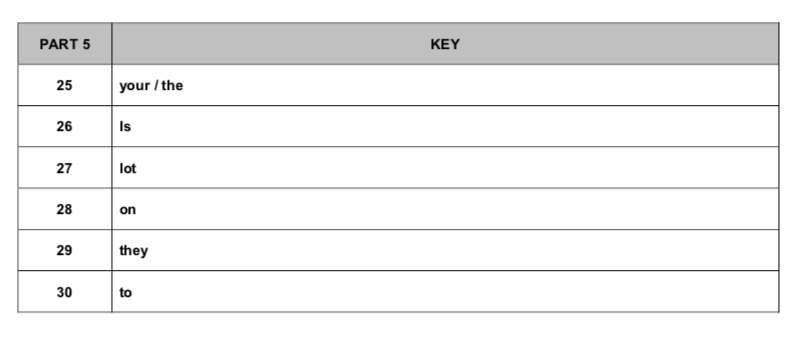About A2 Key Reading and Writing Part 5 and How to approach it
In today’s post, I’m going to look at the task in A2 Key and A2 Key for Schools Reading and Writing Part 5.
In this part, students have to read one email (or perhaps two emails – an email and a reply) of around 95 words in total and complete six gaps.
Let’s look at a sample task, taken from the A2 Key for Schools Sample paper, available to download here.

You can see we have an example followed by 6 gaps.
If we take a look at the answer key for this part, it’s obvious which area of language is being focused on – mainly grammar.

Sometimes in this task, at any level, students think that the missing words must be sophisticated ones, but they certainly aren’t.
Tip: None of the gaps should require the same answer, and sometimes there is more than one possible answer, as we can see here for gap 25.
How students should approach A2 Key Part 6 Reading and Writing
1. Read the whole text first. Don’t stop and try and fill the gaps before you’ve read the whole text.
2. Don’t just look at the gap. Look both before and after the gap.
Let’s look at what’s involved with these gaps:
I’m glad you like (25) ……… new house. If we only read this sentence, then we won’t know if it’s Sasha’s house or Anita’s house. We find this out by reading the previous sentence: ‘Living in Canada sounds great!’
(26) ………. it very cold in Canada? The question mark at the end of this sentence tells us that it’s a question and we don’t have another verb here, so it has to be a verb in the 3rd person singular. The whole first paragraph is in the present simple, so the correct answer is ‘IS’.
I heard that a (27) …………… of Canadians speak two languages – English and French. Here, we have a fixed grammatical phrase – ‘a lot of’.
Do you watch programmes (29) ……………… TV in French too? This tests the use of the correct preposition.
How about the students in your new school? Are (30) ………………… friendly? The gap refers to ‘the students’ in the sentence before, so you need to look back at that to complete this gap. And if you keep reading, the next sentence also helps: ‘…I would like to know more about them.’
I’ve got (30) ……………. go now, but I’ll write again soon. We need ‘to’ after ‘I’ve got’ here. Possibly, if you are more used to ‘have to’, this might not sound so familiar. It’s often tested in this part!
3. Write the words on the lines in the text. ‘Say’ the sentence to yourself in your head (you can’t speak in the exam room but you can ‘say’ it to yourself.) Does it sound right?
4. Write one word in each gap (you never read to write more than one word in this part).
5. When you’ve written a word in all six gaps, transfer your answers to the answer sheet*. WRITE YOUR ANSWERS IN CAPITAL LETTERS.
*Unless you’re doing the exam on computer, in which case, your answers are recorded as you type them.
Language to focus on for this Part
Some typical fixed grammatical phrases which are tested in this part include: a lot of, lots of, a few of, as well as,
Set phrases on the A2 Key wordlist include: at the moment, by the way, except for, first of all, close to, in front of.
And, of course, there are a number of phrasal verbs on the wordlist – again, worth working on these with your students for this part.

